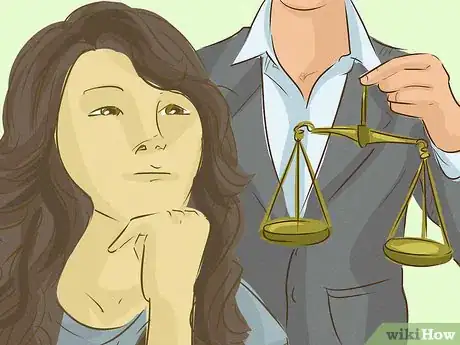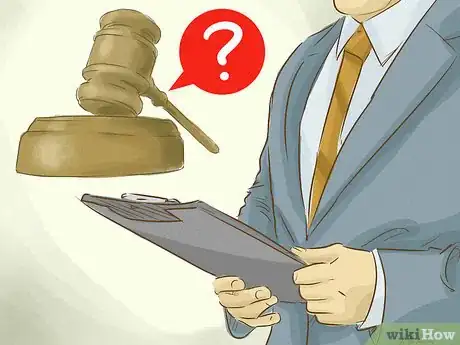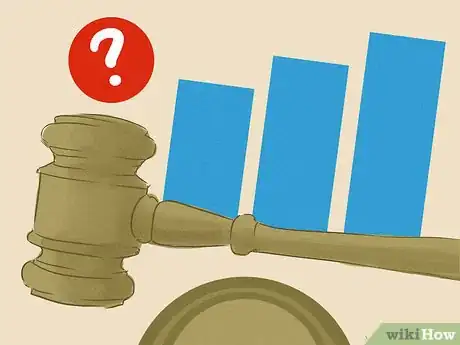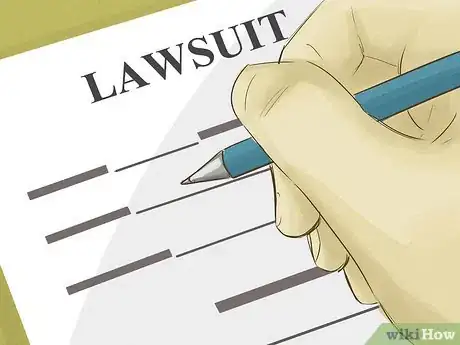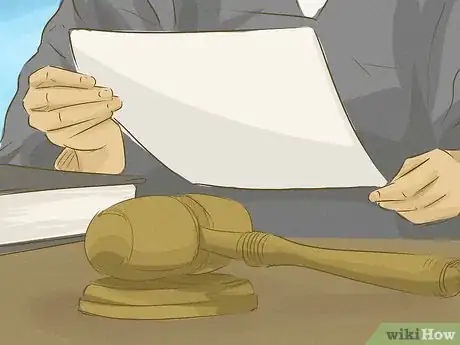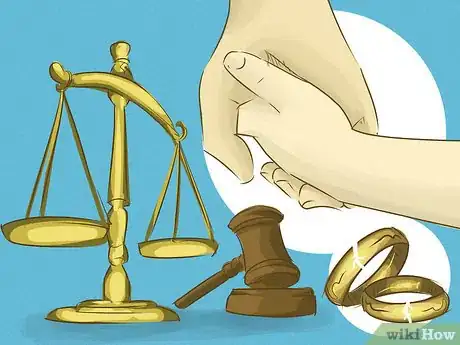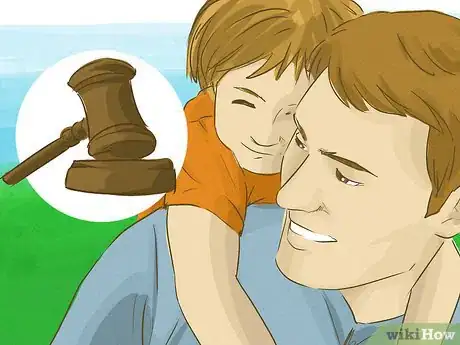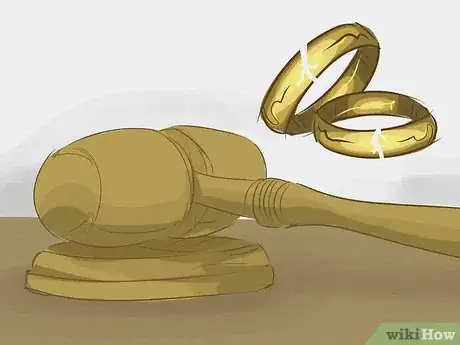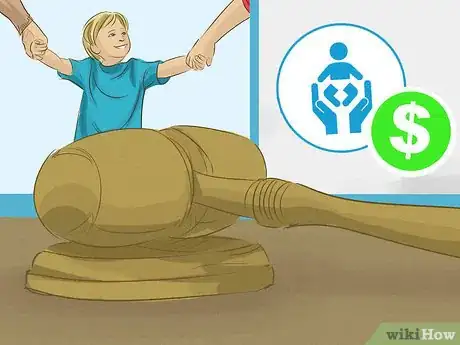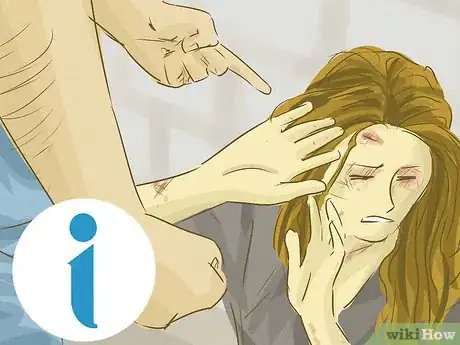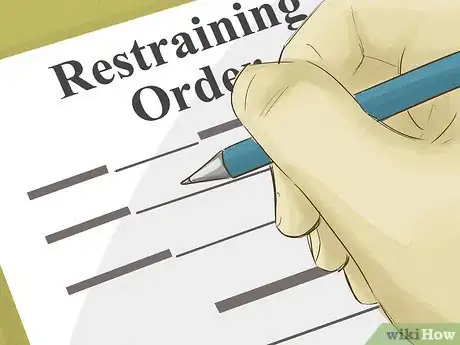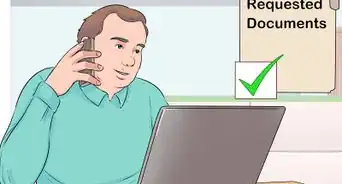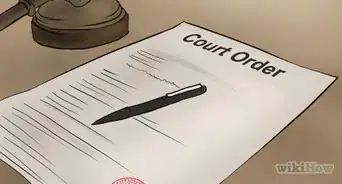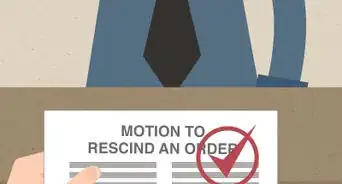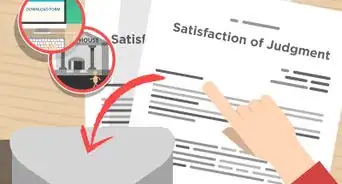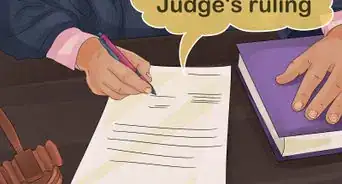This article was co-authored by Clinton M. Sandvick, JD, PhD. Clinton M. Sandvick worked as a civil litigator in California for over 7 years. He received his JD from the University of Wisconsin-Madison in 1998 and his PhD in American History from the University of Oregon in 2013.
There are 14 references cited in this article, which can be found at the bottom of the page.
This article has been viewed 184,098 times.
A court order is a written or spoken decision made by a judge. A court order will instruct a party (either an individual or a business) to either do something or not do something. Court orders are issued in may different types of legal proceedings, for many different reasons. People can get court orders in civil cases, family law cases, and in some instances, when no lawsuit is involved.[1]
Steps
Getting a Court Order in a Civil Case
-
1Determine whether you need a civil court order. Civil court is where people sue each other to collect money damages. Unlike criminal court, losing a civil lawsuit does not result in any jail time. If you want a court to award you money from someone else because you think that they have wronged you in some way, you will need a civil court order. To get a civil order, you must first file a civil lawsuit.[2] There are many types of civil lawsuits, including:
- personal injury lawsuits,
- defamation lawsuits,
- breach of contract lawsuits,
- medical malpractice lawsuits, and
- slip and fall lawsuits.
-
2Consider hiring an attorney. If you want to file a civil lawsuit, an experienced attorney can help you win your libel case. Although you can represent yourself in court, many civil lawsuits are difficult to win, so if possible, you should have an attorney who can advocate for you. Additionally, an attorney will be able to help you navigate the unfamiliar and sometimes complex court system.
- If you do want to hire an attorney, choose someone who has at least 3-5 years of experience handling whatever type of case you have.
- To find an attorney near you, consider talking to friends and family members who have used an attorney before. Find out who they hired, for what type of service, if they were happy with the services, and why or why not. Ask if they would recommend the attorney.
- You can also find an attorney by checking online reviews. Many websites offer free reviews of businesses. Some places to look for lawyer reviews include: FindLaw, Avvo, and Yahoo Local.
Advertisement -
3Decide which type of court to sue in. The law establishes limits on which courts have “jurisdiction” (power) to hear and decide a case. Therefore, it is important that you file your case in a court that has the power to hear your case. In the United States, you will file your civil case in either state or federal court.[3]
- Generally, you should file a case that deals with a state law in state court. The majority of civil cases, including personal injury cases, landlord-tenant cases, and breach of contract are based on state law. Usually, you should file your state court case in the state where the actions occurred.
- There are a few types of cases that should be filed in “federal court” instead of state court. If your case is based on a federal law, you can sue in federal court. A few examples of cases under federal law include: suing a police officer under the federal civil rights statute (called a 1983 case),suing someone for patent infringement, or suing an employer under Title 7 for discrimination.[4]
-
4Decide which level of court to sue in. Once you figure out which state to sue in, you also need to figure out which court in that state is the correct one to sue in: for example, many states have different “levels” of courts that plaintiffs can file in depending on how much money they are asking for. Typically, states will have the following courts (which may have different names) to choose from:
- Small claims court: small claims courts will usually hear claims that involve a certain amount of money - usually up to $2,500 - $5,000.
- Courts for medium-sized claims: usually, the middle level of court will hear cases that involve claims of up to $25,000,
- Courts for any cases with larger claims: there is usually a court that will hear claims that are about $25,000, and also certain specialized statutory claims that specify in the law which court will hear them.
-
5File your lawsuit. After you determine which court you should file your lawsuit in, you should begin to prepare your “complaint.” To sue someone, you must prepare a document called a complaint that you will file with the court. The complaint includes the grounds or cause of action for your lawsuit.[5]
- If you have an attorney, he or she will write and file your complaint.
- If you do not have an attorney, you can look online to see what a complaint for your type of case looks like, or call the court where you will file and ask if there is a special form complaint that you can use.
-
6Try to resolve your case before trial. Even if you file a lawsuit, you won’t necessarily get a court order after a trial. Most cases actually “settle” before trial. Settling with the opposing party is a good idea for many reasons including:
- Timing: trials are often long and drawn out, therefore, settling now means that you will probably receive money sooner rather than later.
- Easier than trial: as someone representing yourself, going all the way through the trial can be stressful due to the complex and unfamiliar nature of the legal system, settling will save you from having to navigate all the way through a trial on your own.
- You will know and agree to the result: if you end up going to trial, you really have no idea how the judge will decide your case, and the order may end up being against you! Settling allows you to agree to the amount of money you will receive, and saves you and your opponent from the uncertainty of trial.
-
7Get a court order after completing the trial process. If you do proceed to trial, your case will either be decided by a judge or a jury. Usually, the parties decide whether to have the case decided by a judge or jury. If you decide to go forward with the lawsuit instead of settling, you should hire an attorney to represent you.
- For more information on how to proceed with a civil lawsuit, visit wikiHow’s guide on Suing in Civil Court.
Getting a Court Order in Family Court
-
1Determine whether you need an order from family court. If you need a court to grant you a divorce, award custody, visitation, or child support, or establish paternity, you will need to get an order from the family court in the state where you live. Every state has different rules and requirements for filing an action in family court, so if possible, you should consult an attorney before taking any action.[6]
- Family court orders are almost always from the family court in the state where the parties reside. If a child is involved, the action is usually filed in the state where the child lives.[7]
- Matters that deal with “family issues,” are almost never filed in federal court. Therefore, if you file for divorce, custody, visitation or paternity, you will file your action in state court.
-
2Get an order establishing paternity. Men are not automatically guaranteed parental rights when a child is born out of wedlock. Additionally, paternity must be established in order to handle issues such as child support, and even custody and visitation. In many cases, paternity can be established without a court order if both the mother of the child and the alleged father agree on paternity. However, if the alleged father does not admit to paternity, you may need a court order.[8] The procedure will differ depending on your state, but usually, the person who wants to establish paternity will file a “Complaint to Establish Paternity.”
- In most cases, the only people who can file in court to establish paternity are the child, the child’s mother, and the alleged father.
- Usually, the court will order a DNA test to determine whether the “father” in the complaint (whether he filed the complaint was named by someone else) is actually the child’s biological father.
- Because paternity cases can be extremely complicated, you should call your local family court to see if there is any help available to help you through the process.
-
3Get a court order granting a divorce. A divorce is a permanent ending of a marital union. All states allow a “no-fault” divorce, which is a divorce where the spouse asking for a divorce does not have to prove that the other spouse did something wrong. To get a no fault divorce, one spouse must simply state a reason for the divorce that is recognized by the state. In most states, it's enough to declare that the couple cannot get along.[9]
- While it is possible to file for divorce yourself, it is often useful to acquire help during the process. Depending on the state you and your spouse live in, you may be able to get help from a “domestic relations clinic” at your courthouse, a low cost attorney, or a legal clinic at a local law school.
- Most state court websites have links to the forms you need to file for divorce. These forms have the legal language in place with space where you can fill in details for yourself and your spouse.
- To get more information on filing for divorce yourself, visit wikiHow’s guide on Filing for Divorce Without an Attorney.
-
4Get a court order for custody, visitation, or child support. Child support and child custody refer to the financial and physical aspects of taking care of a child's needs. Custody and support are responsibilities of both parents, regardless of the couple's relationship status. If you and your spouse/partner cannot come to an agreement on the amount of child support or the custody of your children, the court will enter an order telling both of you what to do.[10]
- If you are in the middle of your divorce, then you likely have a case number or court file already. Therefore, you will not need to file anything extra to get an order regarding custody and support.
- If you are married and have not yet filed for divorce, you will need to file for divorce in order to get a hearing for child custody and support.
- If you have filed for divorce, or are not currently married to your child’s other parent, call the local court clerk (either in the county where you live, or where you filed for divorce) and ask to schedule a hearing for child custody and support.
Filing for an Order of Protection
-
1Understand the types of protective orders you can get. If you are in a situation where someone (whether a spouse, family member, or someone you do not know) has physically harmed you, abused you, or threatened to harm you, you can get a restraining order from the court. Similarly, if you think that your children are being harmed or abused by whoever has custody of them, you may be able to get an emergency custody order to remove the children from the situation.[11]
- If you or your children are in immediate danger or are being stalked and harassed by someone who has threatened you with physical harm, you can get an emergency protective order from the court, which will go into effect more quickly than a restraining order. [12]
-
2Learn how a restraining order or emergency protective order can protect you. If you file a restraining order, a judge will determine the specifics based on your unique situation. Some of the things that a judge can order are:[13]
- ordering abusers or stalkers to avoid any contact with you and/or your children, whether in person, by phone, by email or any other medium.
- Ordering abusers or stalkers not to come within a certain distance of you and/or your children. Most commonly, this distance is 100 yards (91.4 m), but it can be extended well beyond that.
- If you live with the abuser, the judge can order he or she to move out.
- The judge can order that a police escort be present during any necessary contact with the abuser, such as when he or she returns to a shared living space to collect possessions.
-
3File for a restraining order or an emergency protective order. To get a restraining order, you must get the proper forms from the courthouse. Visit the courthouse in your county, the other party's county, or the county where the abuse took place, and ask the clerk for a request form for the type of restraining order you wish to file. While it's not mandatory to have a lawyer with you when you file a restraining order, it would be smart to get an attorney if possible, to answer any extra questions you have about your situation or help you fill out your forms.
- If you have questions but prefer not to hire a lawyer, ask for help from court staff or an advocate, who may be able to answer your question.
- Additionally, you can call a domestic violence hotline to ask about your options, and in some cases, the organization associated with the hotline can provide a lawyer for you. To speak with someone from the National Domestic Violence Hotline, call 1−800−799−7233 or 1−800−787−3224. [14]
- For more information on how to get a restraining order, look at wikiHow’s guide on Getting a Restraining Order.
Expert Q&A
Did you know you can get expert answers for this article?
Unlock expert answers by supporting wikiHow
-
QuestionHow can I get a court order online?
 Barzin Barry Sabahat, JDBarry Sabahat, Esq. has been practicing law in California since 1993. He received his JD from Western State University College of Law in 1992. His current practice is based in the San Francisco Bay Area and focuses on Estate Planning, Transactional Law and drunk driving cases.
Barzin Barry Sabahat, JDBarry Sabahat, Esq. has been practicing law in California since 1993. He received his JD from Western State University College of Law in 1992. His current practice is based in the San Francisco Bay Area and focuses on Estate Planning, Transactional Law and drunk driving cases.
Attorney at Law If you want to get a copy of an existing order, it depends on whether the court has ECF (Electronic Case Filing Capacity.) Federal Courts for example, have ECF / PACER which are the filing and record retrieval services available online. If you are talking about filing and asking for a court order, there is no process by which it can be done online, with the exception of some motions in Federal courts.
If you want to get a copy of an existing order, it depends on whether the court has ECF (Electronic Case Filing Capacity.) Federal Courts for example, have ECF / PACER which are the filing and record retrieval services available online. If you are talking about filing and asking for a court order, there is no process by which it can be done online, with the exception of some motions in Federal courts. -
QuestionWhere do I find a court order form?
 Barzin Barry Sabahat, JDBarry Sabahat, Esq. has been practicing law in California since 1993. He received his JD from Western State University College of Law in 1992. His current practice is based in the San Francisco Bay Area and focuses on Estate Planning, Transactional Law and drunk driving cases.
Barzin Barry Sabahat, JDBarry Sabahat, Esq. has been practicing law in California since 1993. He received his JD from Western State University College of Law in 1992. His current practice is based in the San Francisco Bay Area and focuses on Estate Planning, Transactional Law and drunk driving cases.
Attorney at Law Most court orders are written on "pleading paper," so you may not be able to find the form you need online. However, there are some court orders that are pre-made forms. For example, California family court issues much of its orders in pre-made forms. If a form is available online, then you may be able to find it on the court's website or by running an internet search for the form you need.
Most court orders are written on "pleading paper," so you may not be able to find the form you need online. However, there are some court orders that are pre-made forms. For example, California family court issues much of its orders in pre-made forms. If a form is available online, then you may be able to find it on the court's website or by running an internet search for the form you need. -
QuestionHow do I get a court order if the court is not willing to give me information on my case?
 Barzin Barry Sabahat, JDBarry Sabahat, Esq. has been practicing law in California since 1993. He received his JD from Western State University College of Law in 1992. His current practice is based in the San Francisco Bay Area and focuses on Estate Planning, Transactional Law and drunk driving cases.
Barzin Barry Sabahat, JDBarry Sabahat, Esq. has been practicing law in California since 1993. He received his JD from Western State University College of Law in 1992. His current practice is based in the San Francisco Bay Area and focuses on Estate Planning, Transactional Law and drunk driving cases.
Attorney at Law To get a court order, you will first need to find out why the court is not providing you with information. After that, you can try to address the issue. If you still cannot get the information you need, then the court may be willing to give the information to your attorney with instructions not to share the information with you. In general court files are open for review by public, but there are times when a court file is sealed either because a minor is involved or else the court deems a risk of some sort if the information is available to the public.
To get a court order, you will first need to find out why the court is not providing you with information. After that, you can try to address the issue. If you still cannot get the information you need, then the court may be willing to give the information to your attorney with instructions not to share the information with you. In general court files are open for review by public, but there are times when a court file is sealed either because a minor is involved or else the court deems a risk of some sort if the information is available to the public.
Warnings
- In all cases requiring a court order, it is best to seek the help of an attorney, because the process requires many steps and keen attention to detail. What might seem like a minor oversight to a layperson can mean, at best, having to start the process all over again, and at worst, a permanent waiver of your legal rights. This article provides a brief overview of the basics of how to get a court order in a civil court proceeding. It is not intended as legal advice or a self-help guide for pro-se litigants.⧼thumbs_response⧽
References
- ↑ https://generalcounsel.ncsu.edu/legal-topics/lawsuits-and-litigation/subpoenas-court-orders-and-search-warrants/
- ↑ https://criminal.findlaw.com/criminal-law-basics/the-differences-between-a-criminal-case-and-a-civil-case.html
- ↑ https://www.courts.ca.gov/9617.htm
- ↑ http://www.uscourts.gov/sites/default/files/iaals_civil_case_processing_in_the_federal_district_courts_0.pdf
- ↑ https://www.federalrulesofcivilprocedure.org/what-is-a-civil-complaint/
- ↑ https://www.legalmatch.com/law-library/article/what-is-family-court.html
- ↑ https://cmrs-law.com/attorney-profiles/michael-spillane/determining-home-state/
- ↑ https://www.mass.gov/service-details/learn-about-establishing-paternity
- ↑ https://www.legalmatch.com/law-library/article/divorce.html
- ↑ https://www.courts.ca.gov/17975.htm
- ↑ http://www.courts.state.va.us/forms/district/info_sheet_protective_order_stalking.pdf
- ↑ http://family.findlaw.com/domestic-violence/domestic-violence-orders-of-protection-and-restraining-orders.html
- ↑ https://www.courts.ca.gov/selfhelp-domesticviolence.htm
- ↑ http://www.thehotline.org/
About This Article
A court order is a decision made by a judge that instructs an individual or business what to do in a certain situation. Court orders can be issued in civil cases and family law cases. Civil court is when people sue each other to collect money damages. If you want a court to grant you money from another party because you think they have wronged you in some way, you’ll need a civil court order. If you want to file a civil lawsuit, consider hiring an attorney, who can help advocate for you. If you need a court to grant you a divorce, award custody, visitation, or child support, or establish paternity, you’ll need to get an order from the family court in the state that you live in. To learn how to get a court order in cases where there isn’t a lawsuit, keep reading.

